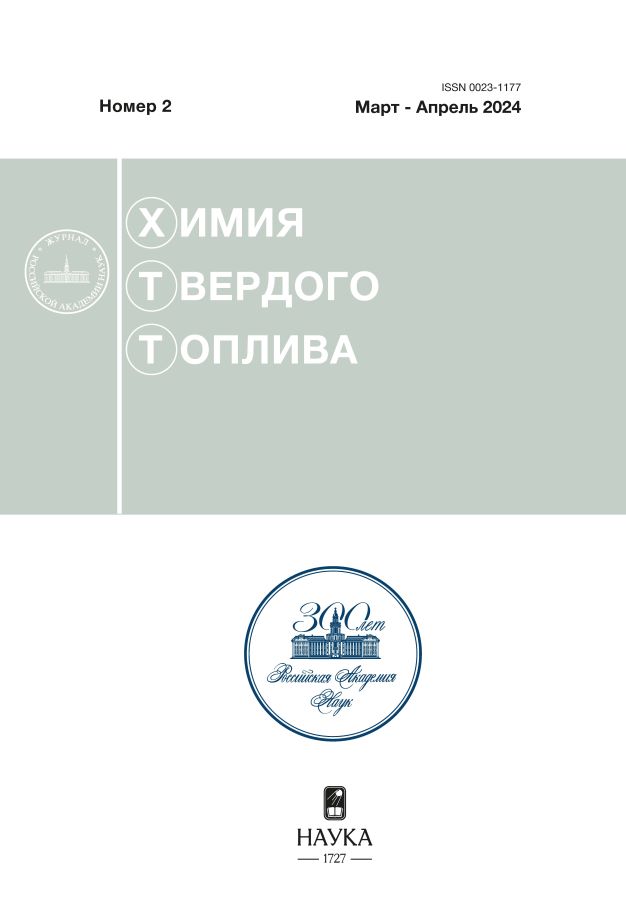Influence of Mineral Components on the Composition of Oil Shale Organic Matter Cracking Products
- Authors: Pantilov P.V.1, Gorbunova M.V.1, Krivtsov E.B.1
-
Affiliations:
- Institute of Petroleum Chemistry, Siberian Branch of the Russian Academy of Sciences
- Issue: No 2 (2024)
- Pages: 44-49
- Section: Articles
- URL: https://rjeid.com/0023-1177/article/view/661588
- DOI: https://doi.org/10.31857/S0023117724020087
- EDN: https://elibrary.ru/OMAYTV
- ID: 661588
Cite item
Abstract
The composition of the oil shale cracking products (OS) from the Kashpirskoe deposit, as well as kerogen isolated from it, has been studied. The influence of OS mineral components on the material balance and cracking products composition is shown. It has been established that the amount of gaseous and solid products in kerogen cracking products decreases, and the yield of liquid products increases. Removal of mineral components from OS leads to an increase in oil content and a decrease in asphaltenes in liquid cracking products, the resin content changes slightly, and the yield of light fractions increases. The peculiarities of the influence of mineral components on the structural-group characteristics of resins and asphaltenes of liquid cracking products have been established. The absence of mineral components leads to enlargement of resin molecules; asphaltene molecules, on the contrary, become more compact.
Keywords
Full Text
About the authors
P. V. Pantilov
Institute of Petroleum Chemistry, Siberian Branch of the Russian Academy of Sciences
Author for correspondence.
Email: 6tinygamer10@gmail.com
Russian Federation, Tomsk
M. V. Gorbunova
Institute of Petroleum Chemistry, Siberian Branch of the Russian Academy of Sciences
Email: mozhayskaya@ipc.tsc.ru
Russian Federation, Tomsk
E. B. Krivtsov
Institute of Petroleum Chemistry, Siberian Branch of the Russian Academy of Sciences
Email: john@ipc.tsc.ru
Russian Federation, Tomsk
References
- World Energy Council. World Energy Focus Annual. 2017. https://www.worldenergy.org/publications/entry/world-energy-focus-2017.
- Sun, Y.; Bai, F.; Liu, B.; Liu, Y.; Guo, M.; Guo, W.; Wang, Q.; Lü, X.; Yang, F.; Yang, Y. // Fuel 2014. V. 115. Р. 338–346.
- World Energy Council. World Energy Resources 2016. https://www.worldenergy.org/publications/2016/world-energy-resources-2016/.
- Ishii, S., Seta M., Nagasaki T., Nakai N., Nagai M., Miyamoto Y., Imada H., Doihata K., Saito K., Sekimoto Y. // Pergamon Press: Oxford, UK, 1990, p. 1285–1291.
- Можайская М.В., Певнева Г.С., Сурков В.Г. // Журн. Сиб. федер. ун-та. Химия. 2021. № 14(2). С. 234–241.
- Патраков Ю.Ф., Федорова Н.И. // Химия твердого топлива. 2009. № 3. С. 3–8.
- Гончаров А.В., Кривцов Е.Б. // Нефтехимия. 2021. Т. 61. № 5. С. 704–712.
- Чернышева Е.А. // Мир нефтепродуктов. 2008. № 1. С. 6–9.
- Можайская М.В., Певнева Г.С., Кривцов Е.Б., Пантилов П.В. // Химия твердого топлива. 2023. № 2–3. С. 20–25.
Supplementary files










